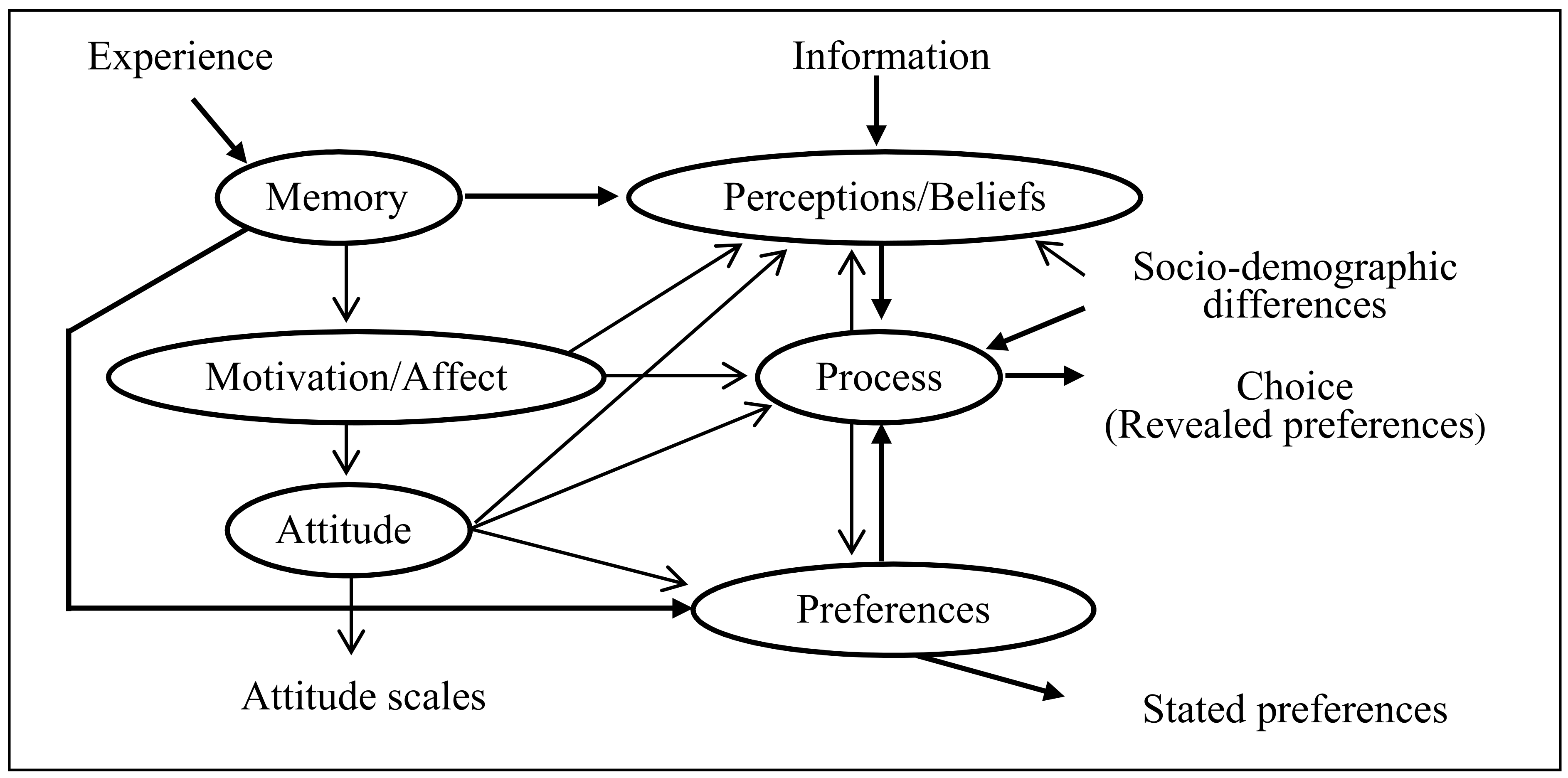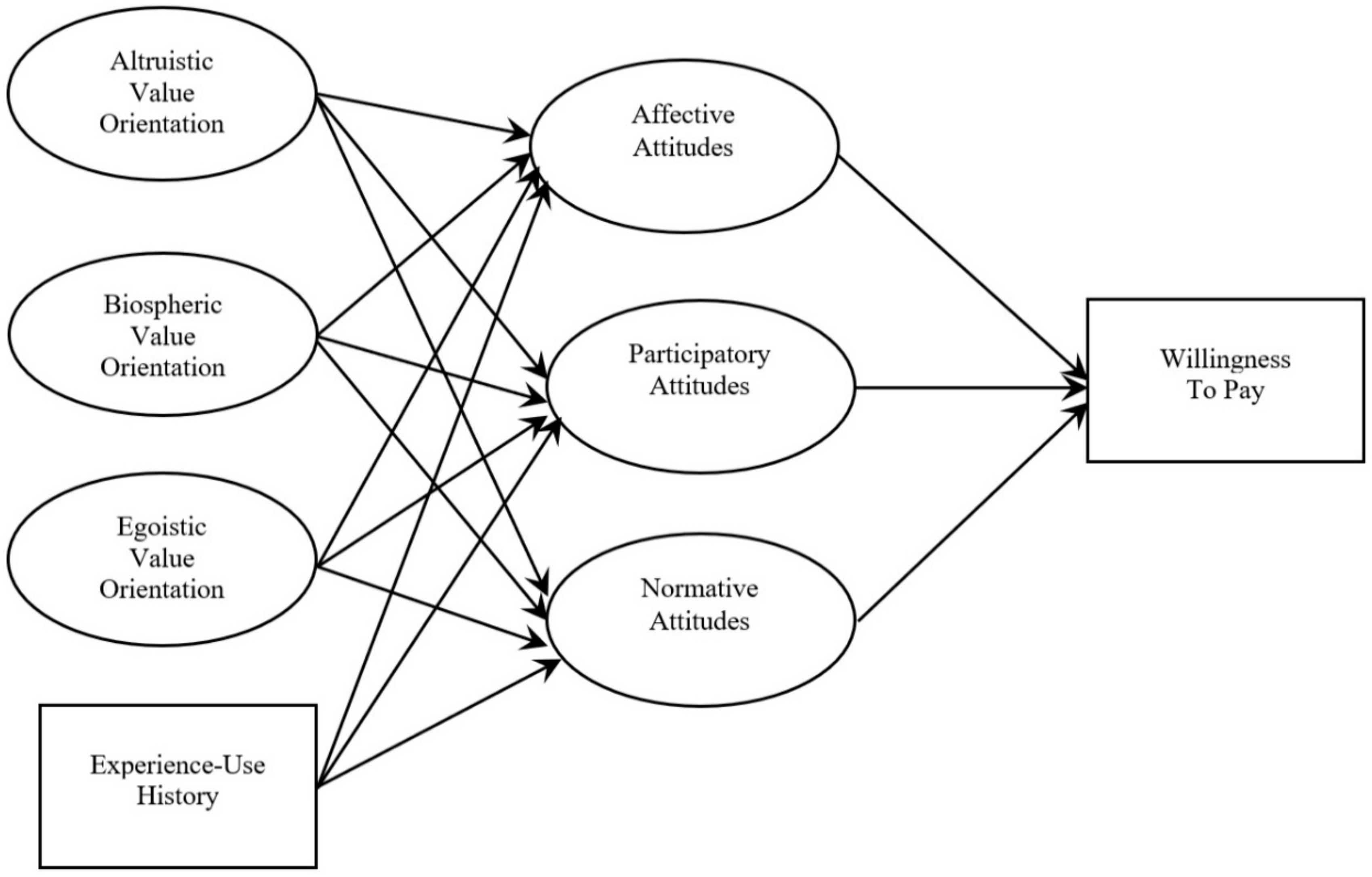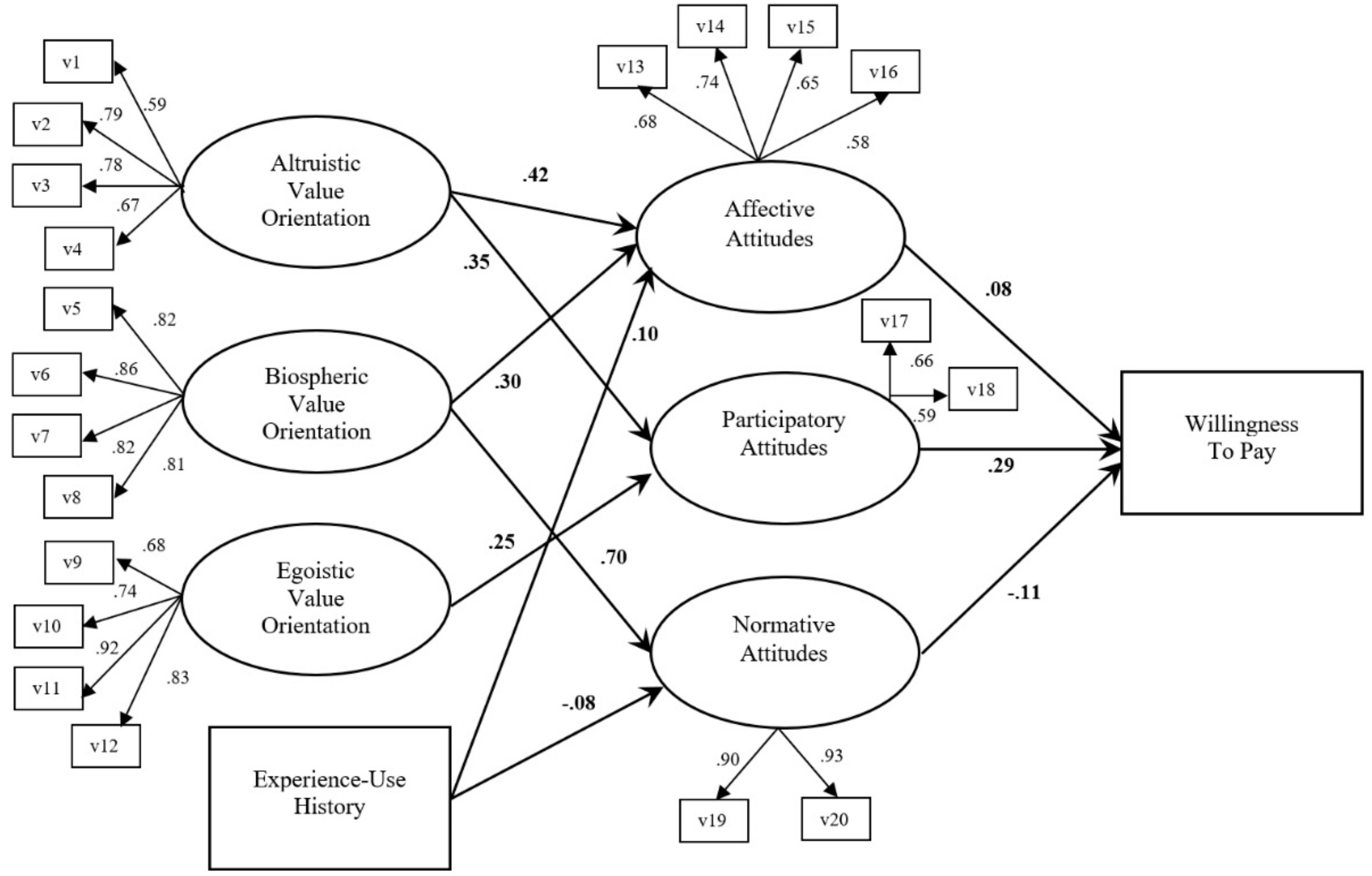The Effects of Environmental Value Orientations and Experience-Use History on the Conservation Value of a National Park
Abstract
:1. Introduction
Research Questions
- RQ1:
- Using a non-market valuation method, what are the economic benefits of conserving Mt. Seorak National Park (i.e., WTP)?
- RQ2:
- How are the three dimensions of value orientations related to the three dimensions of attitudes toward national park management?
- RQ3:
- How is experience-use history related to the three dimensions of attitudes toward national park management?
- RQ4:
- How are the three dimensions of attitudes toward national park management related to WTP?
2. Literature Review
2.1. Non-Market Valuation of conservation Values
2.2. Environmental Value Orientations
2.3. Experience-Use History
2.4. Attitudes toward Park Management
3. Methods
3.1. Study Site
3.2. Data Collection
3.3. Data Analysis and Measurement Instruments
4. Results
4.1. CVM Analysis
4.2. Structural Equation Modeling Analysis
5. Discussions and Conclusion
Author Contributions
Acknowledgments
Conflicts of Interest
References
- Hilgenkamp, K. Environmental Health: Ecological Perspectives; Jones and Bartlett Publishers: Boston, MA, USA, 2006. [Google Scholar]
- Thoyre, A. Constructing environmentalist identities through green neoliberal identity work. J. Polit. Ecol. 2015, 22, 146–163. [Google Scholar] [CrossRef] [Green Version]
- Parker, J.D.; McDonough, M.H. Environmentalism of african americans:An analysis of the subculture and barriers theories. Environ. Behav. 1999, 31, 155–177. [Google Scholar]
- Stern, P.C. New environmental theories: Toward a coherent theory of environmentally significant behavior. J. Soc. Issues 2000, 56, 407–424. [Google Scholar] [CrossRef]
- Stern, P.C.; Dietz, T.; Abel, T.; Guagnano, G.A.; Kalof, L. A value-belief-norm theory of support for social movements: The case of environmentalism. Hum. Ecol. Rev. 1999, 6, 81–97. [Google Scholar]
- Stolton, S.; Dudley, N.; Avcıoğlu Çokçalışkan, B.; Hunter, D.; Ivanić, K.-Z.; Kanga, E.; Kettunen, M.; Kumagai, Y.; Maxted, N.; Senior, J.; et al. Values and benefits of protected areas. In Protected Area Governance and Management; ANU Press: Canberra, Australia, 2015; pp. 145–168. [Google Scholar]
- Kaplan, S. New ways to promote proenvironmental behavior: Human nature and environmentally responsible behavior. J. Soc. Issues 2000, 56, 491–508. [Google Scholar] [CrossRef]
- Kellert, S.R. The Value of Life: Biological Diversity and Human Society; Island Press: Washington, DC, USA, 1996. [Google Scholar]
- Bateman, I.J.; Langford, I.H. Non-users’ willingness to pay for a national park: An application and critique of the contingent valuation method. Reg. Stud. 1997, 31, 571–582. [Google Scholar] [CrossRef]
- Duffield, J.W.; Neher, C.J.; Patterson, D.A. Economic values for national park system resources within the Colorado river watershed. In Proceedings of the Resource Management Symposium, Scottsdale, AZ, USA, 18–20 November 2008; pp. 123–131. [Google Scholar]
- Haefele, M.; Loomis, J.; Bilmes, L. Total economic value of us national park service estimated to be $92 billion: Implications for policy. George Wright Forum 2016, 33, 335–345. [Google Scholar]
- Choi, A.S.; Fielding, K.S. Environmental attitudes as wtp predictors: A case study involving endangered species. Ecol. Econ. 2013, 89, 24–32. [Google Scholar] [CrossRef]
- Spash, C.L.; Urama, K.; Burton, R.; Kenyon, W.; Shannon, P.; Hill, G. Motives behind willingness to pay for improving biodiversity in a water ecosystem: Economics, ethics and social psychology. Ecol. Econ. 2009, 68, 955–964. [Google Scholar] [CrossRef]
- Ajzen, I. The theory of planned behavior. Organ Behav Hum. Decis Processes 1991, 50, 179–211. [Google Scholar] [CrossRef]
- Jansson, J.; Marell, A.; Nordlund, A. Exploring consumer adoption of a high involvement eco-innovation using value-belief-norm theory. J. Consum. Behav. 2011, 10, 51–60. [Google Scholar] [CrossRef]
- Lee, T.H.; Jan, F.-H. The influence of recreation experience and environmental attitude on the environmentally responsible behavior of community-based tourists in Taiwan. J. Sustain. Tour. 2015, 23, 1063–1094. [Google Scholar] [CrossRef]
- Kotchen, M.J.; Reiling, S.D. Environmental attitudes, motivations, and contingent valuation of nonuse values: A case study involving endangered species. Ecol. Econ. 2000, 32, 93–107. [Google Scholar] [CrossRef]
- Aldrich, G.A.; Grimsrud, K.M.; Thacher, J.A.; Kotchen, M.J. Relating environmental attitudes and contingent values: How robust are methods for identifying preference heterogeneity? Environ. Resour. Econ. 2007, 37, 757–775. [Google Scholar] [CrossRef]
- López-Mosquera, N.; Sánchez, M. Theory of planned behavior and the value-belief-norm theory explaining willingness to pay for a suburban park. J. Environ. Manag. 2012, 113, 251–262. [Google Scholar] [CrossRef] [PubMed]
- Obeng, E.A.; Aguilar, F.X. Value orientation and payment for ecosystem services: Perceived detrimental consequences lead to willingness-to-pay for ecosystem services. J Environ. Manag. 2018, 206, 458–471. [Google Scholar] [CrossRef] [PubMed]
- McFadden, D. Economic choices. Am. Econ. Rev. 2001, 91, 351–378. [Google Scholar] [CrossRef]
- Schwartz, S.H. Universals in the content and structure of values: Theoretical advances and empirical tests in 20 countries. In Advances in Experimental Social Psychology; Academic Press: New York, NY, USA, 1992; pp. 1–65. [Google Scholar]
- Stern, P.C.; Dietz, T. The value basis of environmental concern. J. Soc. Issues 1994, 50, 65–84. [Google Scholar] [CrossRef]
- Schwartz, S.H. Normative influences on altruism. In Advances in Experimental Social Psychology; Berkowitz, L., Ed.; Academic Press: New York, NY, USA, 1977; pp. 221–279. [Google Scholar]
- Needham, M.D. Value orientations toward coral reefs in recreation and tourism settings: A conceptual and measurement approach. J. Sustain. Tour. 2010, 18, 757–772. [Google Scholar] [CrossRef]
- Vaske, J.J.; Donnelly, M.P.; Williams, D.R.; Jonker, S. Demographic influences on environmental value orientations and normative beliefs about national forest management. Soc. Nat. Resour. 2001, 14, 761–776. [Google Scholar] [CrossRef]
- Hammond, P.B.; Coppock, R. Valuing the Environment; National Academy Press: Washington, DC, USA, 1990. [Google Scholar]
- Banerjee, B.; McKeage, K. How green is my value: Exploring the relationship between environmentalism and materialism. Adv. Consum. Res. 1994, 21, 147–152. [Google Scholar]
- Fairweather, J.R.; Maslin, C.; Simmons, D.G. Environmental values and response to ecolabels among international visitors to New Zealand. J. Sustain. Tour. 2005, 13, 82–98. [Google Scholar] [CrossRef]
- Hedlund, T. The impact of values, environmental concern, and willingness to accept economic sacrifices to protect the environment on tourists’ intentions to buy ecologically sustainable tourism alternatives. Tour. Hosp. Res. 2011, 11, 278–288. [Google Scholar] [CrossRef]
- Laroche, M.; Bergeron, J.; Barbaro-Forleo, G. Targeting consumers who are willing to pay more for environmentally friendly products. J. Consum. Mark. 2001, 18, 503–520. [Google Scholar] [CrossRef]
- Vaske, J.J.; Donnelly, M.P. A value-attitude-behavior model predicting wildland preservation voting intentions. Soc. Nat. Resour. 1999, 12, 523–537. [Google Scholar]
- Xu, F.; Fox, D. Modelling attitudes to nature, tourism and sustainable development in national parks: A survey of visitors in China and the UK. Tour. Manag. 2014, 45, 142–158. [Google Scholar] [CrossRef] [Green Version]
- Dietz, T.; Stern, P.C.; Guagnano, G.A. Social structural and social psychological bases of environmental concern. Environ. Behav. 1998, 30, 450–471. [Google Scholar] [CrossRef]
- De Groot, J.I.M.; Steg, L. Value orientations to explain beliefs related to environmental significant behavior: How to measure egoistic, altruistic, and biospheric value orientations. Environ. Behav. 2008, 40, 330–354. [Google Scholar] [CrossRef]
- Hammitt, W.E.; McDonald, C.D. Past on-site experience and its relationship to managing river recreation resources. For. Sci. 1983, 29, 262–266. [Google Scholar]
- Ibitayo, O.O.; Virden, R.J. Visitor and manager perceptions of depreciative behaviours in urban park settings. J. Park Recreat. Adm. 1996, 14, 36–51. [Google Scholar]
- Watson, A.E.; Roggenbuck, J.W.; Williams, D.R. The influence of past experience on wilderness choice. J. Leisure Res. 1991, 23, 21–36. [Google Scholar] [CrossRef]
- Holbrook, M.B.; Hirschman, E.C. The experiential aspects of consumption: Consumer fantasies, feelings, and fun. J. Consumer Res. 1982, 9, 132–140. [Google Scholar] [CrossRef]
- Ballantyne, R.; Packer, J.; Falk, J. Visitors’ learning for environmental sustainability: Testing short- and long-term impacts of wildlife tourism experiences using structural equation modelling. Tour. Manag. 2011, 32, 1243–1252. [Google Scholar] [CrossRef] [Green Version]
- Lee, T.H.; Jan, F.H.; Huang, G.W. The influence of recreation experiences on environmentally responsible behavior: The case of liuqiu island, Taiwan. J. Sustain. Tour. 2015, 23, 947–967. [Google Scholar] [CrossRef]
- Chipman, B.D.; Helfrich, L.A. Recreational specializations and motivations of Virginia river anglers. North Amer. J. Fish. Manag. 1988, 8, 390–398. [Google Scholar] [CrossRef]
- McFarlane, B.L. Recreation specialization and site choice among vehicle-based campers. Leis. Sci. 2004, 26, 309–322. [Google Scholar] [CrossRef]
- Ong, T.F.; Musa, G. Examining the influences of experience, personality and attitude on scuba divers’ underwater behaviour: A structural equation model. Tour. Manag. 2012, 33, 1521–1534. [Google Scholar] [CrossRef]
- Backlund, E.A.; Hammitt, W.E.; Bixler, R.D. Experience use history and relationship to the importance of substitute stream attributes. Hum. Dimens. Wildl. 2006, 11, 411–422. [Google Scholar] [CrossRef]
- Hammitt, W.E.; Backlund, E.A.; Bixler, R.D. Experience use history, place bonding and resource substitution of trout anglers during recreation engagements. J. Leis. Res. 2004, 36, 356–378. [Google Scholar] [CrossRef]
- Huang, Y.; Deng, J.; Li, J.; Zhong, Y. Visitors’ attitudes towards China’s national forest park policy, roles and functions, and appropriate use. J. Sustain. Tour. 2008, 16, 63–84. [Google Scholar] [CrossRef]
- Machlis, G.E. Usable knowledge: A progress report on the NPS social science program. Park Sci. 1996, 20, 45–47. [Google Scholar]
- Galloway, G. Psychographic segmentation of park visitor markets: Evidence for the utility of sensation seeking. Tour. Manag. 2002, 23, 581–596. [Google Scholar] [CrossRef]
- Müller, M.; Job, H. Managing natural disturbance in protected areas: Tourists’ attitude towards the bark beetle in a German national park. Biol. Conserv. 2009, 142, 375–383. [Google Scholar] [Green Version]
- Hines, J.M.; Hungerford, H.R.; Tomera, A.N. Analysis and synthesis of research on responsible environmental behavior: A meta-analysis. J. Environ. Educ. 1987, 18, 1–8. [Google Scholar] [CrossRef]
- McCool, S.F.; Lime, D.W. Attitudes of visitors toward outdoor recreation management policy. In Proceedings of the National Outdoor Recreation Forum, Tampa, FL, USA, 13–14 January 1988; pp. 401–411. [Google Scholar]
- Woo, M.; Joo, H. A study on the influence of optional behavior in recreational forests on visitors’ motivation. J. Ind. Econ. Res. 2000, 13, 13–32. [Google Scholar]
- Arnberger, A.; Eder, R.; Allex, B.; Sterl, P.; Burns, R.C. Relationships between national-park affinity and attitudes towards protected area management of visitors to the Gesaeuse national park, Austria. For. Policy Econ. 2012, 19, 48–55. [Google Scholar] [CrossRef]
- Lai, P.H.; Sorice, M.G.; Nepal, S.K.; Cheng, C.K. Integrating social marketing into sustainable resource management at Padre island national seashore: An attitude-based segmentation approach. Environ. Manag. 2009, 43, 985–998. [Google Scholar] [CrossRef] [PubMed]
- Ministry of Environment. National Park Visitors in 2016. Available online: https://www.me.go.kr/home/web/index.do?menuId=286 (accessed on 19 September 2018).
- Korea Tourism Organization. Seoraksan National Park. Available online: http://english.visitkorea.or.kr/enu/ATR/SI_EN_3_1_1_1.jsp?cid=264211 (accessed on 5 July 2018).
- Zhang, X.; Lu, H.; Holt, J.B. Modeling spatial accessibility to parks: A national study. Int. J. Health Geogr. 2011, 10, 31. [Google Scholar] [CrossRef] [PubMed]
- Haab, T.C.; McConnell, K.E. Valuing Environmental and Natural Resources: The Econometrics of Non-Market Valuation; Edward Elgar: Northampton, MA, USA, 2002. [Google Scholar]
- Vaughan, W.J.; Rodriguez, D.J. Obtaining welfare bounds in discrete-response valuation studies: Comment. Land Econ. 2001, 77, 457–465. [Google Scholar] [CrossRef]
- Sillano, M.; de Dios Ortúzar, J. Willingness-to-pay estimation with mixed logit models: Some new evidence. Environ. Plan. A: Econ. Space 2005, 37, 525–550. [Google Scholar] [CrossRef]
- Choi, A.S. Nonmarket values of major resources in the Korean DMZ areas: A test of distance decay. Ecol. Econ. 2013, 88, 97–107. [Google Scholar] [CrossRef]
- Krinsky, I.; Robb, A.L. On approximating the statistical properties of elasticities. Rev. Econ. Stat. 1986, 68, 715–719. [Google Scholar] [CrossRef]
- Kline, R. Principles and Practice of Structural Equation Modeling, 3rd ed.; The Guilford Press: New York, NY, USA, 2016. [Google Scholar]
- Hansla, A.; Gamble, A.; Juliusson, A.; Gärling, T. Psychological determinants of attitude towards and willingness to pay for green electricity. Energy Policy 2008, 36, 768–774. [Google Scholar] [CrossRef]
- Ojea, E.; Loureiro, M.L. Altruistic, egoistic and biospheric values in willingness to pay (WTP) for wildlife. Ecol. Econ. 2007, 63, 807–814. [Google Scholar] [CrossRef]
- Rosenberger, R.S.; Needham, M.D.; Morzillo, A.T.; Moehrke, C. Attitudes, willingness to pay, and stated values for recreation use fees at an urban proximate forest. J. For. Econ. 2012, 18, 271–281. [Google Scholar] [CrossRef]
- Nordlund, A.M.; Garvill, J. Value structures behind proenvironmental behavior. Environ. Behav. 2002, 34, 740–756. [Google Scholar] [CrossRef]
- Schultz, P.W.; Gouveia, V.V.; Cameron, L.D.; Tankha, G.; Schmuck, P.; Franěk, M. Values and their relationship to environmental concern and conservation behavior. J. Cross-Cult. Psych. 2005, 36, 457–475. [Google Scholar] [CrossRef]
- Wesley Schultz, P.; Zelezny, L. Values as predictors of environmental attitudes: Evidence for consistency across 14 countries. J. Environ. Psych. 1999, 19, 255–265. [Google Scholar] [CrossRef]
- Stern, P.C.; Kalof, L.; Dietz, T.; Guagnano, G.A. Values, beliefs, and proenvironmental action: Attitude formation toward emergent attitude objects. J. Appl. Soc. Psych. 1995, 25, 1611–1636. [Google Scholar] [CrossRef]
- Bronfman, N.; Cisternas, P.; López-Vázquez, E.; Maza, C.; Oyanedel, J. Understanding attitudes and pro-environmental behaviors in a Chilean community. Sustainability 2015, 7, 14133–14152. [Google Scholar] [CrossRef]
- Sorice, M.G.; Oh, C.-O.; Ditton, R.B. Managing scuba divers to meet ecological goals for coral reef conservation. AMBIO: J. Hum. Environ. 2007, 36, 316–322. [Google Scholar] [CrossRef]
- Jett, J.S.; Thapa, B.; Ko, Y.J. Recreation specialization and boater speed compliance in manatee zones. Hum. Dimen. Wildl. 2009, 14, 278–292. [Google Scholar] [CrossRef]
- Boyle, K.J. Contingent valuation in practice. In A primer on Nonmarket Valuation; Champ, P.A., Boyle, K.J., Brown, T.C., Eds.; Springer: Boston, MA, USA, 2017; pp. 83–131. [Google Scholar]



| Measurement Items | Standardized Factor Loading | t-Value |
|---|---|---|
| Environmental Value Orientations | ||
| Altruistic value (composite reliability = 0.80) | ||
| Equality (v1) | 0.60 | 17.4 |
| A world at peace (v2) | 0.80 | 25.4 |
| Social justice (v3) | 0.78 | 24.8 |
| Helpful (v4) | 0.66 | 19.7 |
| Biospheric value (composite reliability = 0.87) | ||
| Preventing pollution (v5) | 0.83 | 27.8 |
| Respecting the earth (v6) | 0.87 | 29.9 |
| Unity with nature (v7) | 0.82 | 27.3 |
| Protecting the environment (v8) | 0.80 | 26.7 |
| Egoistic value (composite reliability = 0.87) | ||
| Social power (v9) | 0.68 | 20.9 |
| Wealth (v10) | 0.74 | 23.5 |
| Authority (v11) | 0.91 | 31.8 |
| Ambitious (v12) | 0.83 | 27.3 |
| Visitors’ attitudes toward national park management | ||
| Affective attitudes (composite reliability = 0.76) | ||
| I try to understand the issues and concerns of the national park (v13) | 0.69 | 23.9 |
| I try to protect the natural environment of the national park (v14) | 0.72 | 29.0 |
| I try to understand the lifestyle of locals around the national park (v15) | 0.65 | 20.4 |
| My visit to the national park is good for the local people's lives (v16) | 0.60 | 19.5 |
| Participatory attitudes (composite reliability = 0.64) | ||
| I try to participate in education programs when I visit the national park (v17) | 0.64 | 14.8 |
| I try to participate in tour programs when I visit the national park (v18) | 0.61 | 14.1 |
| Normative attitudes (composite reliability = 0.91) | ||
| I try to follow the rules when I visit the national park (v19) | 0.92 | 45.1 |
| I try to follow the conservation guidelines of the national park (v20) | 0.92 | 45.6 |
| Path | Indirect Effect | Total Effect |
|---|---|---|
| Altruistic Value Orientation → WTP | 0.692 ** (0.148) | |
| Altruistic Value Orientation → Affective Attitudes → WTP | 0.170 * (0.096) | |
| Altruistic Value Orientation → Participatory Attitudes → WTP | 0.523 ** (0.114) | |
| Biospheric Value Orientation → WTP | −0.242 * (0.0129) | |
| Biospheric Value Orientation → Affective Attitudes → WTP | 0.109 * (0.063) | |
| Biospheric Value Orientation → Normative Attitudes → WTP | −0.351 ** (0.127) | |
| Egoistic Value Orientation → WTP | 0.340 ** (0.079) | |
| Egoistic Value Orientation → Participatory Attitudes → WTP | 0.340 ** (0.079) | |
| Experience-Use History → WTP | 0.019 ** (0.007) | |
| Experience-Use History → Affective Attitudes → WTP | 0.009 * (0.005) | |
| Experience-Use History → Normative Attitudes → WTP | 0.010 ** (0.004) |
© 2018 by the authors. Licensee MDPI, Basel, Switzerland. This article is an open access article distributed under the terms and conditions of the Creative Commons Attribution (CC BY) license (http://creativecommons.org/licenses/by/4.0/).
Share and Cite
Han, J.H.; Choi, A.S.; Oh, C.-O. The Effects of Environmental Value Orientations and Experience-Use History on the Conservation Value of a National Park. Sustainability 2018, 10, 3372. https://doi.org/10.3390/su10103372
Han JH, Choi AS, Oh C-O. The Effects of Environmental Value Orientations and Experience-Use History on the Conservation Value of a National Park. Sustainability. 2018; 10(10):3372. https://doi.org/10.3390/su10103372
Chicago/Turabian StyleHan, Ju Hyoung, Andy S. Choi, and Chi-Ok Oh. 2018. "The Effects of Environmental Value Orientations and Experience-Use History on the Conservation Value of a National Park" Sustainability 10, no. 10: 3372. https://doi.org/10.3390/su10103372
APA StyleHan, J. H., Choi, A. S., & Oh, C.-O. (2018). The Effects of Environmental Value Orientations and Experience-Use History on the Conservation Value of a National Park. Sustainability, 10(10), 3372. https://doi.org/10.3390/su10103372






